Up to 40 World War II veterans, who took part in the evacuation of Dunkirk, yesterday gathered to commemorate the event's 70th anniversary.
50 of the original "little ships" which helped to rescue over 300,000 Allied troops from the advancing Germans also attended the ceremony at Dunkirk.
British, French, Canadian and Belgian soldiers were rescued from Dunkirk beaches between May 26 and June 4, 1940 by an armada of 700 little ships from Britain, including fishing boats, pleasure craft and RNLI lifeboats. Also present were 42 Royal Navy destroyers.
Tears were shed during a ceremony which remembered the massacre of 80 British soldiers by the SS. The troops were herded into a barn and killed by grenade and machine gun.
Also attending the ceremony were army, navy and airforce cadets, who no doubt spoke to many of the veterans to hear their amazing tales.
British police officers also attended the ceremony to pay their respects.
Dunkirk is often seen as a military disaster on the part of Allied troops. Though if the British ("the whole root and core and brain of the British Army") were destroyed by the advancing Germans then Germany would probably have invaded Britain - a disaster not just for Britain but possibly for the world.
Dunkirk veterans recall blood-soaked sands as they commemorate 70th anniversary of evacuation
By Daily Mail Reporter
29th May 2010
Daily Mail

Prince Michael, Queen Elizabeth II's cousin, laid a wreath at the ceremony
Second World War veterans today recalled the blood-soaked sands as they joined survivors on Dunkirk beach to mark the 70th anniversary of the famous troop evacuation.
Up to 40 former soldiers attended the ceremony at the Allied Memorial on Dunkirk seafront, with 50 of the original 'little ships' that took part in the operation offshore.
Several days of commemorations are taking place in the northern French port to celebrate the famous mission that rescued more than 300,000 Allied troops stranded on the beaches in 1940.
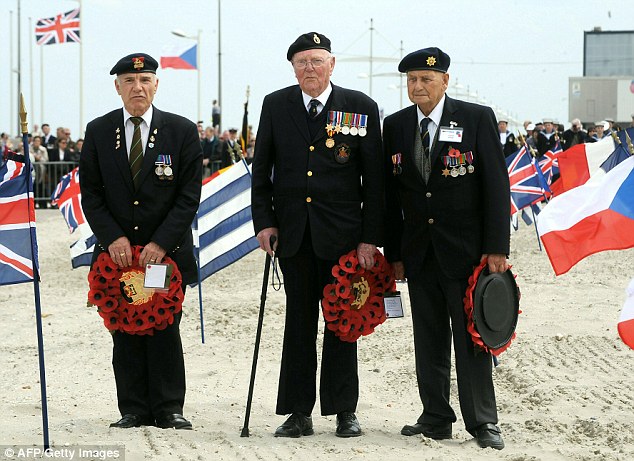
Three British WWII veterans prepare to lay flowers in front of a commemorative monument devoted to dead Allied soldiers during a ceremony today in Malo-les-Bains located on the French northern city of Dunkirk

A selection of Met police officers escorted the veterans to the ceremony
Yesterday tears were shed at a ceremony remembering the SS massacre of more than 80 British soldiers at Esquelbecq, just outside Dunkirk.
They had been protecting the town's outer defences and after being taken prisoner by soldiers from SS Leibstandarte Adolf Hitler, were herded into a barn and killed by grenade and machine gun.
British, French, Canadian and Belgian soldiers were rescued from Dunkirk beaches between May 27 and June 4, 1940.
John Davis, who fought in the rearguard, described seeing 'headless and limbless torsos with stomachs ripped out'.
He said the 'sweet smell of death' was overwhelming.
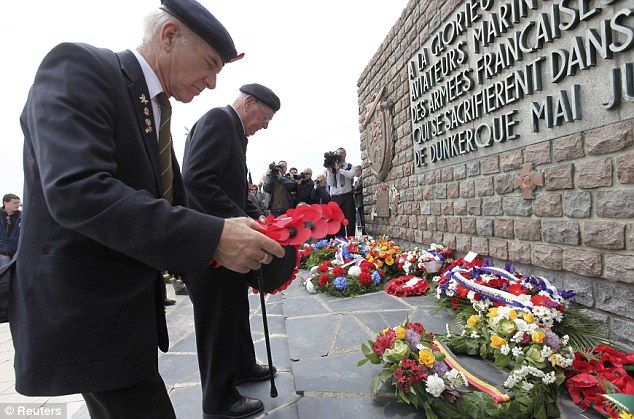
Wreaths are laid at the Allied Memorial during the ceremony, which commemorates the 70th anniversary of the famous troop evacuation
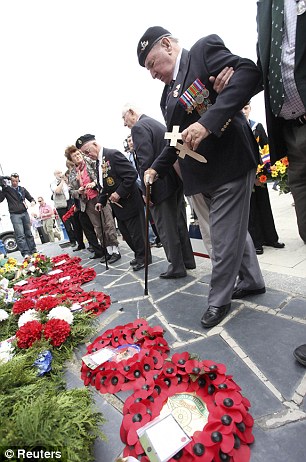
Veterans at the event recalled the horrific sight of the beaches being soaked with the blood of their comrades
Mr Davis told Sky News: 'Seventy years ago these sands were blood-soaked. They were running with blood.
'Each half an hour there was a raid and always there were 30 to 50 wounded or dead and we had to get stretcher bearers and also take the dead off and give them some sort of resting place.
'We couldn't bury them, we hadn't time or the place or the means so we covered them with tarpaulins to give them some respect.
'After the fifth day I noticed the stench - the sweet smell of death. It was really awful because it was much warmer than it is today. It was a glorious summer so we had this stench of death around us.

A flotilla of small ships sets sail from Ramsgate, Kent for France to mark the 70th anniversary of Operation Dynamo to rescue troops from the beaches of Dunkirk

Two people in uniform watch the reenactment of Operation Dynamo

Veterans and military vehicles leave a car ferry in Dunkirk port for the procession in the streets to celebrate the anniversary of the Dunkirk evacuation operation called Dynamo

A boat sailed by Rodney Bewes, which was used in the Dunkirk evacuation, makes its way down the Thames past Parliament
'I was rearguard. I was kept busy but I was all the while aware of this smell and the smoke from the tanks that was drifting over. It was very, very traumatic.
'I'd only ever seen neighbours laid nicely in coffins. Now I'd seen headless and limbless torsos with stomachs ripped out. It was a shocking sight for a 19-year-old.'
Mr Davis, one of the last to escape, only made it after struggling aboard a third ship. The first two were blown up.
He said it was possibly the last time he would visit Dunkirk because he was getting 'a bit long in the tooth', adding: 'I give thanks for my deliverance.'
Another veteran, Private Ken Blake, said: 'All these things are still in your mind.
You don't forget. You can't forget.'
Prince Michael of Kent joined soldiers past and present for the multinational service which saw wreaths laid and a flame of remembrance lit.
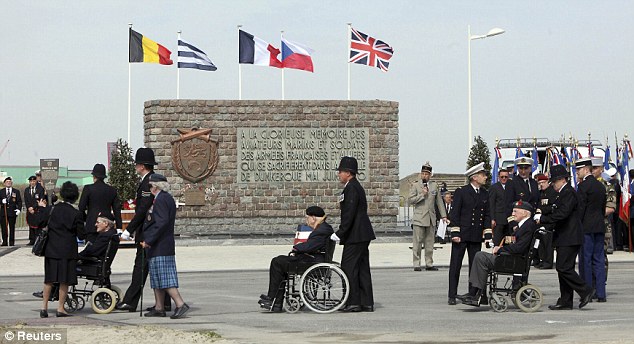
British, French, Canadian and Belgian soldiers were rescued from Dunkirk beaches between May 26 and June 4, 1940
The flags of Britain, France, Czechoslovakia and Germany flew over the large stone memorial as a minute's silence was held and national anthems were played.
A bike ride for the forces' charity Help for Heroes was also finishing in the town today after a 320-mile trip from Portsmouth.
The cyclists will return to Dover by Royal Navy landing craft tomorrow.
The Dunkirk evacuation, 27th May - 4th June 1940
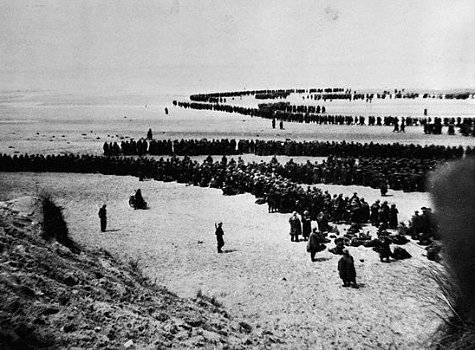
The Dunkirk evacuation, or Operation Dynamo, was the evacuation of British, Canadian, French and Belgian soldiers from the beaches and harbour of Dunkirk in Northern France when they were cut off by the German army during the Battle of Dunkirk. The remarkable operation was directed from Dover Castle, built in the 12th Century by King Henry II.
In his now famous "We shall fight on the beaches" speech to the House of Commons, British Prime Minister Winston Churchill called the events in France "a colossal military disaster", saying that "the whole root and core and brain of the British Army" had been stranded at Dunkirk and seemed about to perish or be captured. He hailed their rescue as a "miracle of deliverance.
On the first day, only 7,010 men were evacuated, but by the ninth day, a total of 338,226 soldiers (198,229 British and 139,997 French) had been rescued by the hastily assembled fleet of 850 boats which sailed from Britain.
Many of the troops were able to embark from the harbour's protective mole onto 42 British destroyers and other large ships, while others had to wade from the beaches toward the ships, waiting for hours to board, shoulder-deep in water. Others were ferried from the beaches to the larger ships, and thousands were carried back to England by the famous "little ships of Dunkirk", a flotilla of around 700 merchant marine boats, fishing boats, pleasure craft and Royal National Lifeboat Institution lifeboats—the smallest of which was the 15-foot fishing boat Tamzine, now in the Imperial War Museum—whose civilian crews were called into service for the emergency. The "miracle of the little ships" remains a prominent folk memory in Britain.
"Dunkirk spirit", a phrase used to describe the tendency of the British public to pull together and overcome times of adversity, are still heard in Britain today.

Operation Dynamo took its name from the dynamo room in the naval headquarters below Dover Castle, which contained the dynamo that provided the building with electricity during the war. It was in this room that British Vice Admiral Bertram Ramsay planned the operation and briefed Winston Churchill as it was under way
dailymail.co.uk
50 of the original "little ships" which helped to rescue over 300,000 Allied troops from the advancing Germans also attended the ceremony at Dunkirk.
British, French, Canadian and Belgian soldiers were rescued from Dunkirk beaches between May 26 and June 4, 1940 by an armada of 700 little ships from Britain, including fishing boats, pleasure craft and RNLI lifeboats. Also present were 42 Royal Navy destroyers.
Tears were shed during a ceremony which remembered the massacre of 80 British soldiers by the SS. The troops were herded into a barn and killed by grenade and machine gun.
Also attending the ceremony were army, navy and airforce cadets, who no doubt spoke to many of the veterans to hear their amazing tales.
British police officers also attended the ceremony to pay their respects.
Dunkirk is often seen as a military disaster on the part of Allied troops. Though if the British ("the whole root and core and brain of the British Army") were destroyed by the advancing Germans then Germany would probably have invaded Britain - a disaster not just for Britain but possibly for the world.
Dunkirk veterans recall blood-soaked sands as they commemorate 70th anniversary of evacuation
By Daily Mail Reporter
29th May 2010
Daily Mail

Prince Michael, Queen Elizabeth II's cousin, laid a wreath at the ceremony
Second World War veterans today recalled the blood-soaked sands as they joined survivors on Dunkirk beach to mark the 70th anniversary of the famous troop evacuation.
Up to 40 former soldiers attended the ceremony at the Allied Memorial on Dunkirk seafront, with 50 of the original 'little ships' that took part in the operation offshore.
Several days of commemorations are taking place in the northern French port to celebrate the famous mission that rescued more than 300,000 Allied troops stranded on the beaches in 1940.

Three British WWII veterans prepare to lay flowers in front of a commemorative monument devoted to dead Allied soldiers during a ceremony today in Malo-les-Bains located on the French northern city of Dunkirk

A selection of Met police officers escorted the veterans to the ceremony
Yesterday tears were shed at a ceremony remembering the SS massacre of more than 80 British soldiers at Esquelbecq, just outside Dunkirk.
They had been protecting the town's outer defences and after being taken prisoner by soldiers from SS Leibstandarte Adolf Hitler, were herded into a barn and killed by grenade and machine gun.
British, French, Canadian and Belgian soldiers were rescued from Dunkirk beaches between May 27 and June 4, 1940.
John Davis, who fought in the rearguard, described seeing 'headless and limbless torsos with stomachs ripped out'.
He said the 'sweet smell of death' was overwhelming.

Wreaths are laid at the Allied Memorial during the ceremony, which commemorates the 70th anniversary of the famous troop evacuation

Veterans at the event recalled the horrific sight of the beaches being soaked with the blood of their comrades
Mr Davis told Sky News: 'Seventy years ago these sands were blood-soaked. They were running with blood.
'Each half an hour there was a raid and always there were 30 to 50 wounded or dead and we had to get stretcher bearers and also take the dead off and give them some sort of resting place.
'We couldn't bury them, we hadn't time or the place or the means so we covered them with tarpaulins to give them some respect.
'After the fifth day I noticed the stench - the sweet smell of death. It was really awful because it was much warmer than it is today. It was a glorious summer so we had this stench of death around us.

A flotilla of small ships sets sail from Ramsgate, Kent for France to mark the 70th anniversary of Operation Dynamo to rescue troops from the beaches of Dunkirk

Two people in uniform watch the reenactment of Operation Dynamo

Veterans and military vehicles leave a car ferry in Dunkirk port for the procession in the streets to celebrate the anniversary of the Dunkirk evacuation operation called Dynamo

A boat sailed by Rodney Bewes, which was used in the Dunkirk evacuation, makes its way down the Thames past Parliament
'I was rearguard. I was kept busy but I was all the while aware of this smell and the smoke from the tanks that was drifting over. It was very, very traumatic.
'I'd only ever seen neighbours laid nicely in coffins. Now I'd seen headless and limbless torsos with stomachs ripped out. It was a shocking sight for a 19-year-old.'
Mr Davis, one of the last to escape, only made it after struggling aboard a third ship. The first two were blown up.
He said it was possibly the last time he would visit Dunkirk because he was getting 'a bit long in the tooth', adding: 'I give thanks for my deliverance.'
Another veteran, Private Ken Blake, said: 'All these things are still in your mind.
You don't forget. You can't forget.'
Prince Michael of Kent joined soldiers past and present for the multinational service which saw wreaths laid and a flame of remembrance lit.

British, French, Canadian and Belgian soldiers were rescued from Dunkirk beaches between May 26 and June 4, 1940
The flags of Britain, France, Czechoslovakia and Germany flew over the large stone memorial as a minute's silence was held and national anthems were played.
A bike ride for the forces' charity Help for Heroes was also finishing in the town today after a 320-mile trip from Portsmouth.
The cyclists will return to Dover by Royal Navy landing craft tomorrow.
The Dunkirk evacuation, 27th May - 4th June 1940

The Dunkirk evacuation, or Operation Dynamo, was the evacuation of British, Canadian, French and Belgian soldiers from the beaches and harbour of Dunkirk in Northern France when they were cut off by the German army during the Battle of Dunkirk. The remarkable operation was directed from Dover Castle, built in the 12th Century by King Henry II.
In his now famous "We shall fight on the beaches" speech to the House of Commons, British Prime Minister Winston Churchill called the events in France "a colossal military disaster", saying that "the whole root and core and brain of the British Army" had been stranded at Dunkirk and seemed about to perish or be captured. He hailed their rescue as a "miracle of deliverance.
On the first day, only 7,010 men were evacuated, but by the ninth day, a total of 338,226 soldiers (198,229 British and 139,997 French) had been rescued by the hastily assembled fleet of 850 boats which sailed from Britain.
Many of the troops were able to embark from the harbour's protective mole onto 42 British destroyers and other large ships, while others had to wade from the beaches toward the ships, waiting for hours to board, shoulder-deep in water. Others were ferried from the beaches to the larger ships, and thousands were carried back to England by the famous "little ships of Dunkirk", a flotilla of around 700 merchant marine boats, fishing boats, pleasure craft and Royal National Lifeboat Institution lifeboats—the smallest of which was the 15-foot fishing boat Tamzine, now in the Imperial War Museum—whose civilian crews were called into service for the emergency. The "miracle of the little ships" remains a prominent folk memory in Britain.
"Dunkirk spirit", a phrase used to describe the tendency of the British public to pull together and overcome times of adversity, are still heard in Britain today.

Operation Dynamo took its name from the dynamo room in the naval headquarters below Dover Castle, which contained the dynamo that provided the building with electricity during the war. It was in this room that British Vice Admiral Bertram Ramsay planned the operation and briefed Winston Churchill as it was under way
dailymail.co.uk
Last edited: